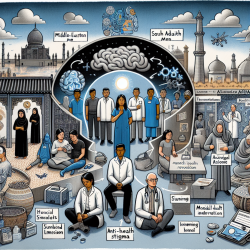Introduction
Stigma surrounding mental health is a pervasive issue globally, affecting individuals' access to care and overall quality of life. This blog explores the findings of a recent literature review on mental health stigma in Asian nations and low-and-middle-income countries (LMICs), comparing them with high-income countries (HICs). The review highlights the cultural nuances of stigma and the effectiveness of various anti-stigma interventions. Practitioners can leverage these insights to enhance their approaches and advocate for further research in this critical area.
Understanding Mental Health Stigma
Mental health stigma can manifest at multiple levels: structural, societal, and individual. It is influenced by cultural beliefs, societal norms, and health policies. In many Asian and LMICs, stigma is often rooted in traditional beliefs, such as viewing mental illness as a spiritual failing or a result of supernatural forces. These cultural factors contribute to the reluctance to seek treatment and perpetuate discrimination against individuals with mental health conditions.
Comparative Analysis: LMICs vs. HICs
The literature review reveals that while HICs have established comprehensive anti-stigma campaigns with favorable outcomes, similar efforts in LMICs are often generalized and lack long-term effectiveness data. In HICs, interventions are typically disorder-specific and involve various stakeholders, including patients, caregivers, and health professionals. In contrast, LMICs tend to implement population-based, educative interventions that may not address the specific needs of different groups.
Effective Strategies for Reducing Stigma
To effectively reduce mental health stigma, a multi-modal approach is necessary. This includes:
- Education: Raising awareness about mental health conditions and debunking myths through public campaigns, media involvement, and educational programs.
- Contact-Based Interventions: Encouraging interactions between the public and individuals with lived experiences to foster understanding and empathy.
- Policy and Legislation: Developing and implementing mental health policies that protect the rights of individuals with mental health conditions and promote access to care.
- Community Engagement: Involving community leaders, religious figures, and local organizations in anti-stigma initiatives to ensure cultural relevance and acceptance.
Implications for Practitioners
Practitioners can play a crucial role in reducing mental health stigma by incorporating culturally sensitive approaches in their practice. This involves understanding the cultural context of their clients, advocating for inclusive policies, and participating in community-based interventions. Additionally, practitioners should engage in continuous education to stay informed about effective anti-stigma strategies and contribute to research efforts in this field.
Conclusion
Addressing mental health stigma requires a concerted effort from practitioners, policymakers, and communities. By understanding the cultural determinants of stigma and implementing evidence-based interventions, we can create more inclusive and supportive environments for individuals with mental health conditions. Practitioners are encouraged to explore further research and actively participate in anti-stigma initiatives to drive meaningful change.
To read the original research paper, please follow this link: Stigma towards mental illness in Asian nations and low-and-middle-income countries, and comparison with high-income countries: A literature review and practice implications.










